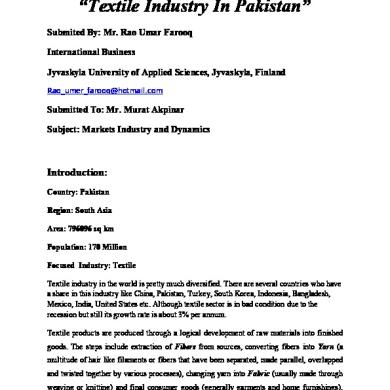Cutlery Industry In Pakistan
This document was uploaded by user and they confirmed that they have the permission to share it. If you are author or own the copyright of this book, please report to us by using this DMCA report form. Report DMCA
Overview
Download & View Cutlery Industry In Pakistan as PDF for free.
More details
- Words: 278
- Pages: 22
• [email protected] • BBA(IT)
Group Members • Rao Zeshan
030740-042
• Asad Raza sayed
060904-005
• AB.Rehman Akbar • Ibrar Husain
042805015
• Zaheer-ud-deen babar
083705-073
Cutlery industry (Pakistan,(wazirabad))
Introduction
1) kitchen and table cutlery 2) Non-kitchen and non-table cutlery
Safety Razor Blades
Scissors, Talilors' Shears & Similar Shears and Blades Therefor
Erasing Knives
Letter Openers
Pencil Sharpeners & Blades Thereof
Manicure or Pedicure Sets & Instruments (Including Nail Files)
Forks ,sponns
Sets of Assorted Articles containing atleast One Article Plated with Precious Metal Forks
Fish Knives
Ladles Pruning KnivKnives n.ses
Knife Blades Paper Knives
Other Sets of Assorted Articles
Table Knives
History • Discovery of Stainless Steel (Henry Brearley 1913)
• Evolution of the cutlery industry • Development of cutlery industry in Pakistan • A Culture based industry
Locations • Wazirabad, Nazimabad and Allahbad in Gujranwala district • 300 units present in this region
Production and capacity utilization • Almost 25,000 people are associated directly with this sector • capacity utilization is only 30 to 40 percent • 90 percent of these products are sold locally
Cutlery exports
Cutlery imports
Comparison b/w Imports and exports
Raw material • Local (Gujranawala, Lahore) • Imported (America ,China )
Production process
Production process..cont
Production process….cont
Scrap utilization
Technological level
• Traditional style of manufacturing • No technology According to world View
Pricing • Cost plus pricing • China is price leader
Government policies and incentives
Problems faced by industry • Labor problems (bonded labor) • Health Hazard • Obsolete technology • Brand Development • Inconsistent government policies
Future prospects (after WTO) • SMEDA , TDAP and other organizations are working • WTO is a bad thing for Third world
Conclusion
Group Members • Rao Zeshan
030740-042
• Asad Raza sayed
060904-005
• AB.Rehman Akbar • Ibrar Husain
042805015
• Zaheer-ud-deen babar
083705-073
Cutlery industry (Pakistan,(wazirabad))
Introduction
1) kitchen and table cutlery 2) Non-kitchen and non-table cutlery
Safety Razor Blades
Scissors, Talilors' Shears & Similar Shears and Blades Therefor
Erasing Knives
Letter Openers
Pencil Sharpeners & Blades Thereof
Manicure or Pedicure Sets & Instruments (Including Nail Files)
Forks ,sponns
Sets of Assorted Articles containing atleast One Article Plated with Precious Metal Forks
Fish Knives
Ladles Pruning KnivKnives n.ses
Knife Blades Paper Knives
Other Sets of Assorted Articles
Table Knives
History • Discovery of Stainless Steel (Henry Brearley 1913)
• Evolution of the cutlery industry • Development of cutlery industry in Pakistan • A Culture based industry
Locations • Wazirabad, Nazimabad and Allahbad in Gujranwala district • 300 units present in this region
Production and capacity utilization • Almost 25,000 people are associated directly with this sector • capacity utilization is only 30 to 40 percent • 90 percent of these products are sold locally
Cutlery exports
Cutlery imports
Comparison b/w Imports and exports
Raw material • Local (Gujranawala, Lahore) • Imported (America ,China )
Production process
Production process..cont
Production process….cont
Scrap utilization
Technological level
• Traditional style of manufacturing • No technology According to world View
Pricing • Cost plus pricing • China is price leader
Government policies and incentives
Problems faced by industry • Labor problems (bonded labor) • Health Hazard • Obsolete technology • Brand Development • Inconsistent government policies
Future prospects (after WTO) • SMEDA , TDAP and other organizations are working • WTO is a bad thing for Third world
Conclusion
Related Documents

Cutlery Industry In Pakistan
May 2020 7
Textile Industry In Pakistan
June 2020 17
Carpet Industry In Pakistan
December 2019 22
Sports Industry In Pakistan
December 2019 23
Construction Industry In Pakistan
May 2020 18